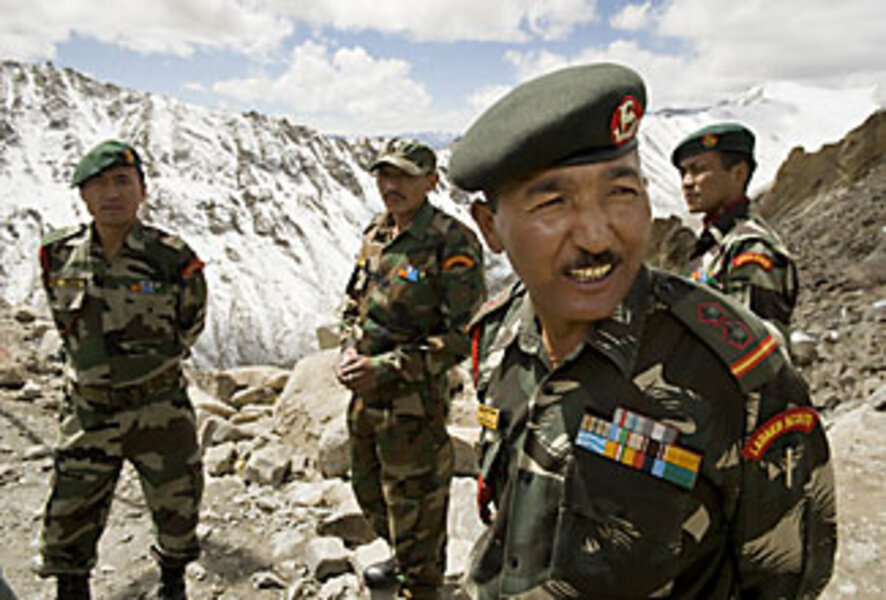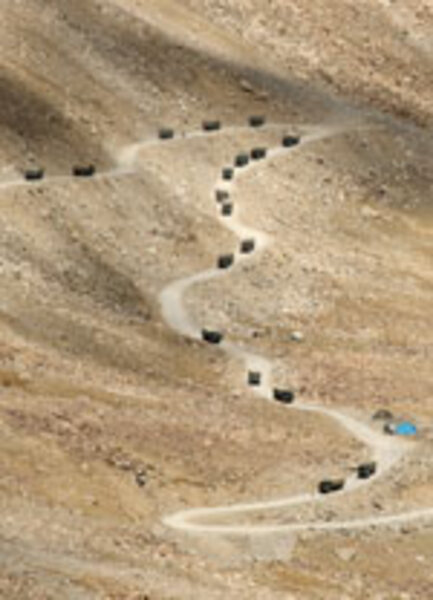Growing number of China incursions into India lead to a strategy change
Loading...
| Leh, India
First came the Chinese helicopters, flying low. Then came the Indian officials asking what happened. Suddenly, the tiny Himalayan village of Demchok stands at the center of rising tensions between the world's two most populous nations.
Villagers told an Indian delegation recently that the two Chinese choppers buzzed the village in August and flew several miles into Indian territory, according to Tsering Mutp, a retired Indian soldier who attended the meeting. Mr. Mutp says the villagers had some pointed questions for the visiting officials. In particular, they asked why on the Chinese side of the river there are paved roads and development but nothing on their side.
The answer lies in India's strategy for dealing with China's land claims. In the past, India has deliberately neglected the roads and other infrastructure in such border regions to slow down any possible invasion, says Brahma Chellaney, a security expert at the Center for Policy Research in New Delhi. But in response to a major spike in cross-border incursions by the Chinese in the past few years, the Indian approach is changing, with plans to expand infrastructure and bring more of a government footprint to the contested region.
"Now the Chinese are basically doing so much damage on the Tibetan plateau, and given these Chinese border incidents and provocations, the Indians have been left with no choice but to begin infrastructure development along the Himalayas," says Mr. Chellaney.
Chinese incursions jumped from 140 in 2007 to 280 in 2008, says Chellaney. The Indian government is trying to downplay mounting reports in the India media of Chinese incursions in Ladakh and Uttarakhand and says this year has seen "no significant increase."
"That is alarming. That means the Chinese are still sustaining pressure at last year's level," says Chellaney.
China officially denies incursions. "Border patrols are strictly conducted according to the law and will never enter [Indian] territory," Foreign Ministry spokesperson Jiang Yu said last month.
The Indian government has tried to keep the issue out of the public square, calling it media "hype." Good relations with Beijing are important to Delhi: China is now India's largest trading partner.
But India is also quietly building up the border.
A journey to Ladakh
In September, the Indian Air Force opened a new high-altitude airfield here in the district of Ladakh in the country's far north, bordering both China and Pakistan. It follows the building of two other fields in the Himalayas in the last 15 months, including the world's highest at 16,200 feet at Daulat Beg Oldi.
India is currently repositioning Sukhoi war jets to its northeastern borders with China. Air Chief Marshal P V Naik said earlier this month that while the Chinese posed no imminent threat, there was a jet gap.
"Our present aircraft strength is inadequate. Aircraft strength is one third that of China. The government of India is doing a lot to augment Air Force capability," he said.
India also approved construction of four strategic roads in Ladakh – part of a wider road-building effort across the Himalayas. Crews can already be seen beavering away on remote mountain roads in Ladakh, burying new wiring.
Leh, the capital of Ladakh, is burgeoning with new development and tourism – a trend stoked partly by patriotism. "It should grow quite fast and quite big. That's the best deterrent for people who create problems at the border," says a developer visiting from Delhi with a construction proposal for the district government.
The two countries fought a bloody border war in 1962, leaving unresolved issues over the precise border. Since 1981, the two have been in talks to finalize the 2,000-mile sprawling border to no avail. Among the sticking points is China's claim of a piece of Indian-controlled territory three times the size of Taiwan.
Recent media reports of incursions in Ladakh range from the brazen to the bizarre: Chinese soldiers painting "China" on rocks inside Indian territory, Chinese boats surrounding an Indian vessel on a high-altitude border lake, and the dropping of frozen food from the air.
Mr. Mutp, who drove the deputy commissioner of Ladakh to Demchok, said the villagers had not heard of air-dropped food, and mostly seemed to think it was distant city folk who were making a fuss. (The deputy commissioner refused to talk about Chinese incursions and the military restricts access to Demchok and other border areas.)
Chinese weather
Even in Leh, residents mostly shrug off the Chinese incursions, speaking about them as if they were a cyclic part of the weather.
Others express some concern about creeping militarization. "There might be more armies transferred to the border to protect [it]," says Rigzin Dhonup, a university student from Ladakh. He says that while the Army is disciplined and well-behaved, more troops would raise tensions and perhaps provoke China or Pakistan into responding.
Leh already houses the entire 14th Corps of the Indian Army, as well as an indigenous force called the Ladakh Scouts. Soldiers are frequently seen walking through the bazaars.
Active and former soldiers and Scouts who have patrolled the Chinese border describe it as mostly a relaxed affair, with handwaves exchanged at times across the river. However, the Hindustan Times newspaper reports that along the border at Pangong Lake, Indian soldiers who used to patrol unarmed now carry weapons.
A colonel currently serving in the 14th Corps, who says he is not authorized to speak, describes regular monthly meetings involving the exchange of gifts and discussions between the two patrolling forces on parts of the border.
The recent activity from the Chinese he says is "normal" and "it's just to keep busy." When asked which country – Pakistan or China – is more threatening to India, he says "both are equally."
Over time, however, that view has been shifting. Chellaney agrees with India's former Air Force chief Fali Homi, who says China is now the greater threat. Chellaney points out that China has delivered military assistance to Pakistan, Sri Lanka, Burma, and Nepal.
Some of those Chinese partnerships can be seen as gaining footholds in the Indian Ocean and its shipping lanes from the oil-rich Middle East. But these countries also encircle the Indian mainland.
"The idea is to constrain India's strategic options," Chellaney says. "The idea is not to actually use force but to create a situation where India stays on good behavior."
Could emerging competition between India and China lead to conflict?







